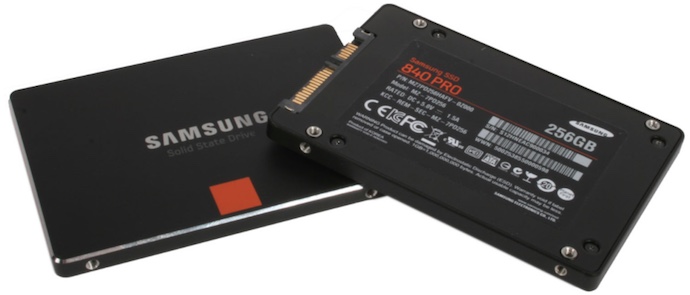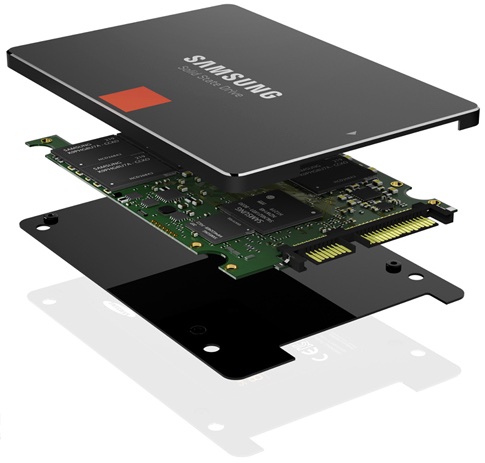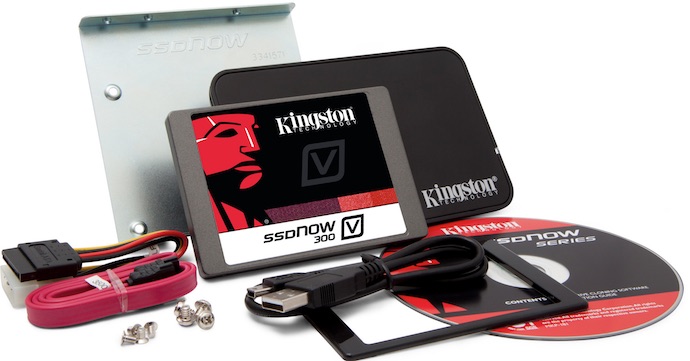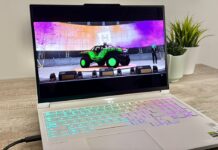
SSD’s Technological Edge
Solid state storage has several distinct advantages over the hard drives that have traditionally been used for PC storage.
Hard drive technology is a precisely coordinated series of moving parts. A magnetic platter spins rapidly inside a housing, while an arm-mounted read/write head moves across it to read or write data. Think of an SSD like a turntable playing a vinyl record and you have the idea, only instead of rotating at 33 or 45 rpm, even a relatively slow laptop hard drive’s platter spins at 5400 rpm! Data is written in blocks that get fragmented as the drive fills up, and that means the read/write head is constantly zooming back and forth.
As the name implies, SSD technology is “solid” in the sense that there are no moving parts. Flash memory is used to store data, making the process of reading and writing significantly faster. Besides speed, the amount of physical space required for an SSD is much smaller than a hard drive—in some cases, the SSD isn’t even in a “drive” form factor, but instead looks like a stick of RAM that fits in a slot on the motherboard.
Hard drives have served us well, but compared to SSD’s they are slow, inefficient and delicate.
How Big a Difference Will an SSD Make?
 It’s hard to overstate the speed advantage of SSDs compared to a hard drive, although there are some areas where the difference is much more pronounced than others. One of the first things you’ll notice is your computer’s startup time. I replaced the 7200 rpm hard drive in an old MacBook Pro with an SSD and the boot time—from a cold start to the point where I could begin using the computer—dropped from over one minute to under 10 seconds. Waking from sleep with an SSD often takes less than one second.
It’s hard to overstate the speed advantage of SSDs compared to a hard drive, although there are some areas where the difference is much more pronounced than others. One of the first things you’ll notice is your computer’s startup time. I replaced the 7200 rpm hard drive in an old MacBook Pro with an SSD and the boot time—from a cold start to the point where I could begin using the computer—dropped from over one minute to under 10 seconds. Waking from sleep with an SSD often takes less than one second.
Any operation requiring the computer to locate and load data is also much faster using an SSD since the delay of having a read/write head move around the platter is eliminated. This translates into much faster launch times for applications, as well as faster disk operations like copying or saving. Even when it comes to a steady sustained data transfer, on average SSDs can be two to four times faster than most hard drives. New PCIe SSDs like the kind found in the MacBook Pro and Dell’s new XPS 15 offer speeds that can double those of the fastest previous generation SSDs.
Kingston is one of the leading SSD manufacturers and it published this graphic showing the overall speed of operation of its SSDs compared to a fast, 7200 rpm hard drive using a standard test suite. The net result when you upgrade to an SSD is much faster start times, faster copy times, applications that launch near instantly and zippier overall performance.
SSD’s Available in Higher Capacity Than Ever
Most computers today still ship with hard drives for storage and up until a few years ago, solid state drives were included primarily in premium laptops. This is primarily because of two factors. First, SSDs were much more expensive per GB of storage than hard drives. Second, SSDs were available only in lower capacity configurations.
I say “were” because with time the equation has changed significantly. As manufacturers ramp up production and technology advances, SSDs have significantly narrowed the price and capacity gap with hard drives. Looking at SSD options right now at Best Buy, I can see a 480GB SSD selling for less than I paid for my first SSD three or four years ago—and it was a 32GB model. That Dell XPS 15 laptop I mentioned earlier? Its SSD isn’t just a lightning fast PCIe model, it’s also a whopping 1TB capacity. Samsung even released a 16TB SSD last year, marking the first time the largest capacity 2.5-inch drive available was an SSD rather than a traditional hard drive. I wouldn’t want to shell out for one of those 16TB versions mind you, but the point is, capacity is no longer an issue with SSDs and prices are definitely becoming less of a barrier.
 Added SSD Benefits
Added SSD Benefits
Speed is the big advantage when it comes to adding an SSD to your system, but there are other benefits as well, especially for laptop users. Among the pluses you’ll see by upgrading to an SSD:
- No mechanical parts means no noise and no vibration
- Very little operational heat is produced
- Wider range of operating temperatures than hard drives and much less sensitivity to extreme temperatures
- A fraction of the weight of a hard drive
- Lower power consumption (one half to one third that of a typical hard drive)
- Safe from exposure to magnetic fields that can erase a hard drive
Is there a downside to this storage technology? Well, nothing is perfect … The biggest concern with SSDs is limited write/erase cycles for each cell in the Flash memory bank. However, they are equipped with software (most use TRIM) that optimizes the cycles, making it highly unlikely an SSD will fail before your entire system is so obsolete it’s been recycled.
SSD Installation
In most cases, replacing your hard drive with an SSD is easier than you might think. SSDs are available mounted in cases that duplicate the form factor of a hard drive, complete with the same connectors, making it an easy swap. I’ve replaced the hard drive with an SSD in all of my older laptops (including a first generation MacBook Air that actually shipped with a tiny HDD), and it’s typically a 15-20 minute process. Not counting data backup—always back up your data first.

Some ultra portable laptops may have storage that’s not user replaceable, but in that case, it’s an SSD anyway so you wouldn’t be in an upgrade situation. If you aren’t sure about the upgradability of your laptop or desktop PC, or if you’re uncomfortable with the idea of cracking it open yourself, bring it in to the Geek Squad team and ask them about options.
When an older PC starts to feel a little underwhelming in performance, there are two components that offer big “bang for the buck” results. Increasing the amount of RAM installed is always a quick win (read all the details in Gadjo’s post). The other half of the performance boost equation is faster storage and that means upgrading to a solid state drive. Either one of these upgrades will result in a big performance increase, but the additional RAM and an SSD together? Your PC will feel like a new computer.



